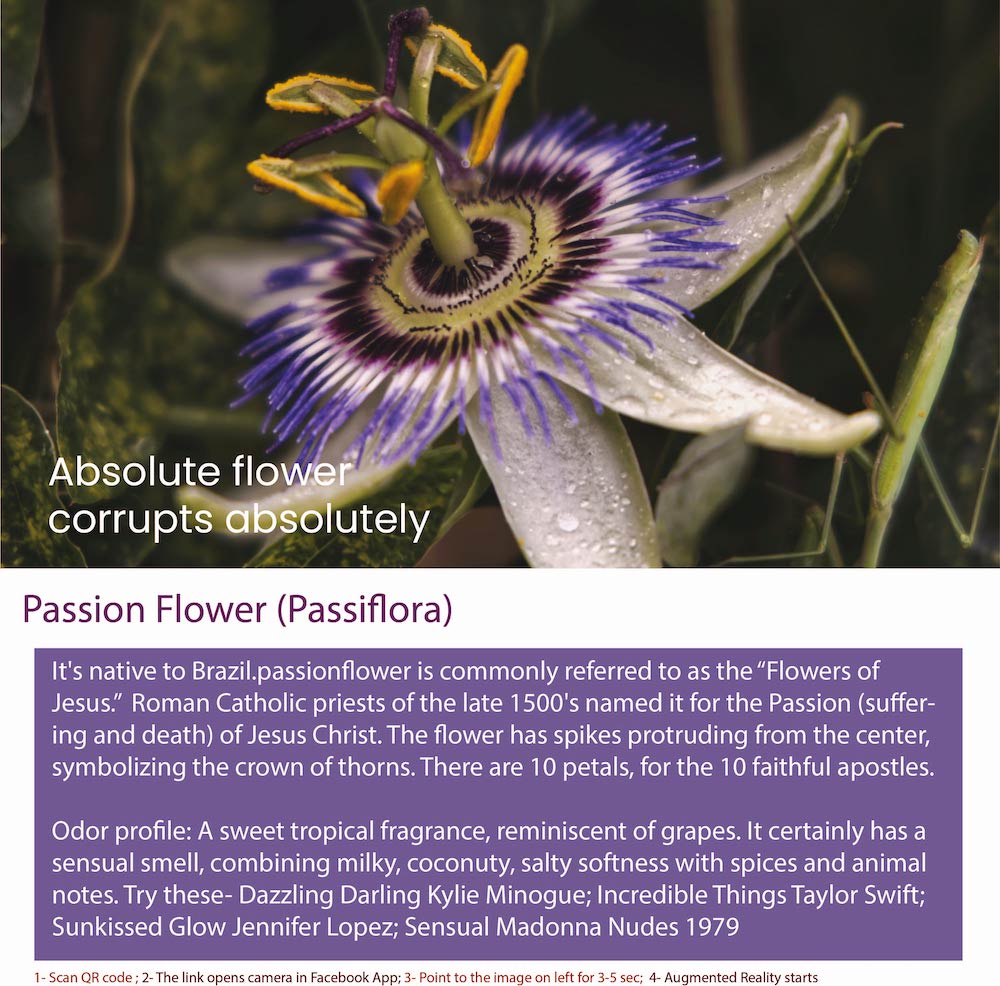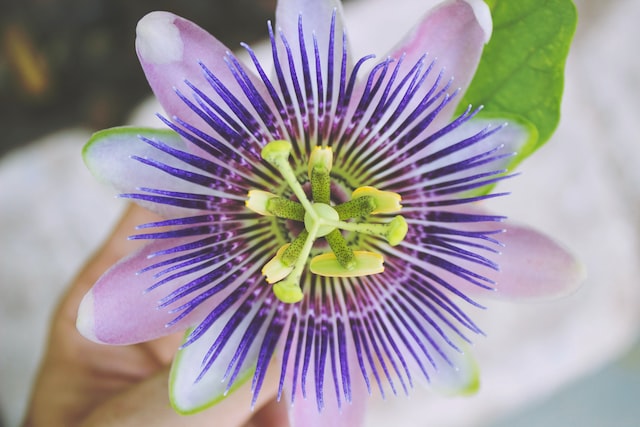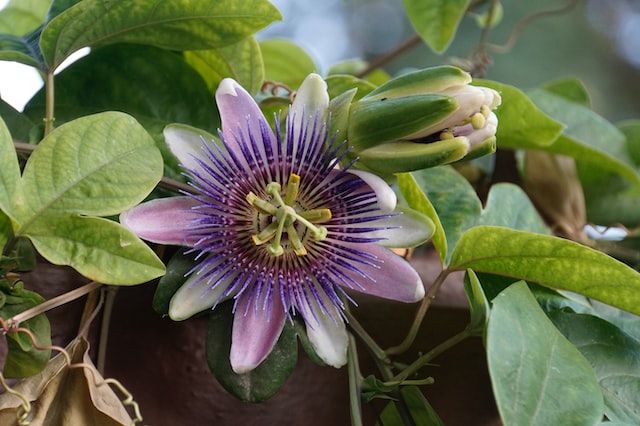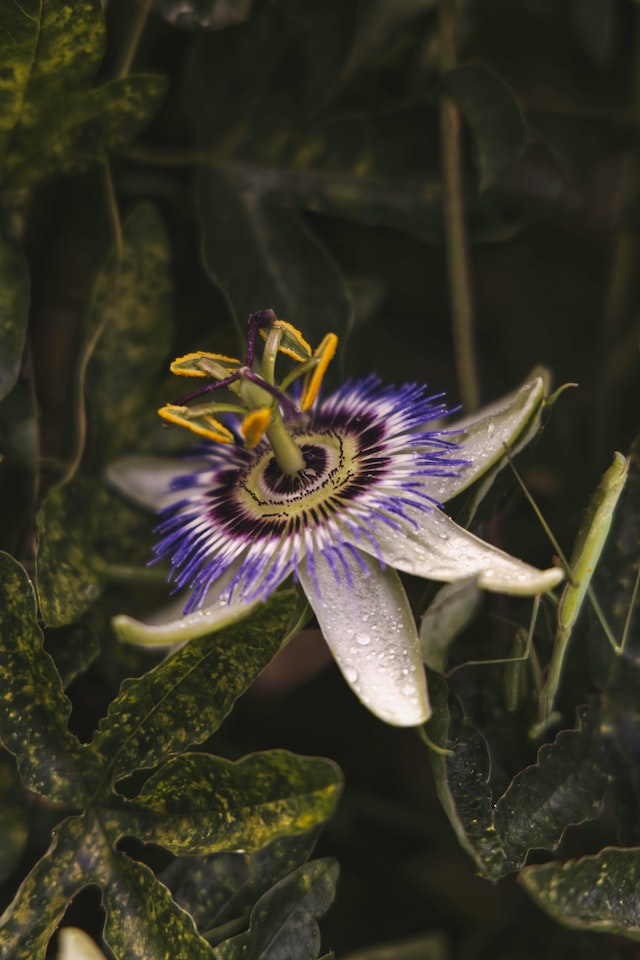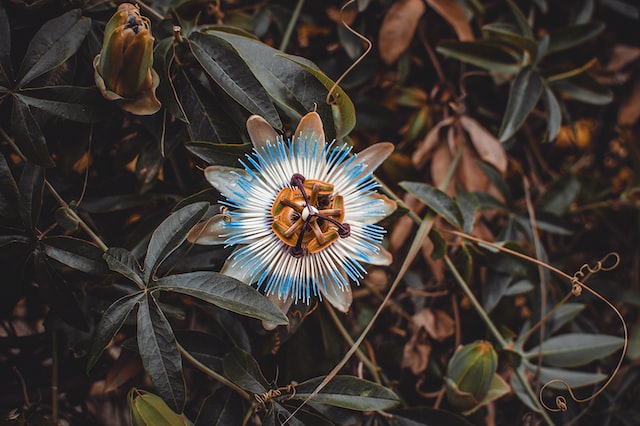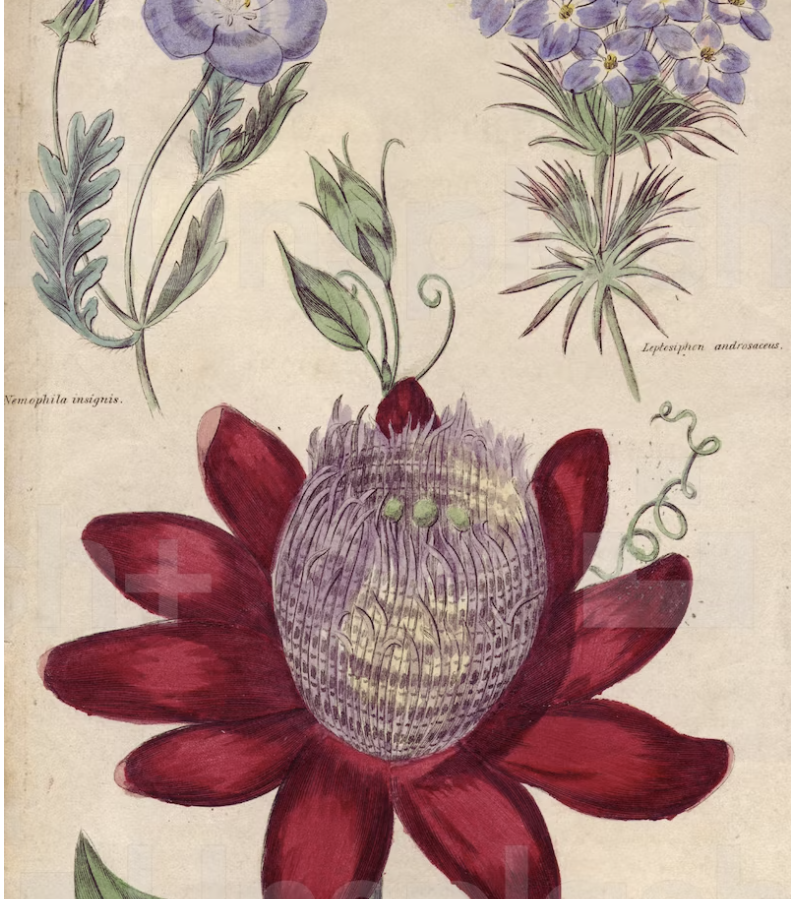Passion Flower Fragrance Collection
Passion Flower: The Enigmatic Beauty of Calm and Intrigue
Introduction: Passion Flower, with its enigmatic and captivating allure, is a remarkable botanical treasure known for its striking appearance and potential therapeutic properties. Scientifically known as Passiflora, this flower belongs to the Passifloraceae family and has a rich history of traditional use in various cultures. From inspiring perfumers with its delicate fragrance to offering potential benefits in therapeutic oils and herbal medicine, Passion Flower is more than just a mesmerizing bloom. This essay delves into the captivating world of Passion Flower, encompassing its presence in perfumes, therapeutic oils, food, medicinal systems, historical significance, and intriguing fun facts about this extraordinary and beneficial plant.
The Enchantment of Passion Flower: Passion Flower's distinctive appearance sets it apart from other flowers. Its intricate and beautiful structure has earned it the name "Passion Flower," as it is said to represent the crucifixion of Christ. The flower's name is derived from the Latin word "passio," meaning suffering, referring to the passion of Christ. Passion Flowers come in various species, each with unique colors and shapes, but they all share a captivating allure that has inspired awe and wonder for centuries.
Perfumes and Fragrance: While Passion Flower is not commonly used in perfumery to extract essential oils, its delicate and subtle fragrance has inspired perfumers to create synthetic compounds that evoke its enchanting scent. Passion Flower-inspired perfumes may carry hints of floral sweetness and a touch of tropical allure, adding a sense of tranquility and romance to fragrance compositions.
Therapeutic Oils and Aromatherapy: Passion Flower essential oil is not widely available or commonly used in aromatherapy. However, some therapeutic oils with similar properties, like Lavender or Chamomile, may be used to promote relaxation and alleviate stress. The aroma of Passion Flower essential oil, if available, would likely be calming and soothing.
Medicinal Applications: Passion Flower has a long history of use in traditional medicine systems, particularly in Central and South America. The plant is known for its potential calming and sedative properties, making it valuable in herbal remedies for promoting relaxation and alleviating anxiety and insomnia. Passion Flower is also believed to have potential analgesic and anti-inflammatory effects.
Historical Significance: The indigenous peoples of the Americas, including the Aztecs and Incas, valued Passion Flower for its medicinal and cultural significance. Spanish explorers later brought Passion Flower back to Europe, where it was admired for its unique appearance and potential therapeutic properties. Passion Flower has since become a symbol of passion, devotion, and spirituality in various cultures.
Fun and Crazy Facts:
Passion Flower, with its enigmatic beauty and potential therapeutic properties, is a captivating and cherished botanical wonder. From its presence in perfumes to its potential uses in therapeutic oils and herbal medicine, Passion Flower continues to intrigue and inspire with its delicate allure. As we admire the ethereal beauty and historical significance of Passion Flower, we are reminded of the timeless allure of nature's botanical treasures and the profound mysteries that lie within the captivating blooms of the world.
Introduction: Passion Flower, with its enigmatic and captivating allure, is a remarkable botanical treasure known for its striking appearance and potential therapeutic properties. Scientifically known as Passiflora, this flower belongs to the Passifloraceae family and has a rich history of traditional use in various cultures. From inspiring perfumers with its delicate fragrance to offering potential benefits in therapeutic oils and herbal medicine, Passion Flower is more than just a mesmerizing bloom. This essay delves into the captivating world of Passion Flower, encompassing its presence in perfumes, therapeutic oils, food, medicinal systems, historical significance, and intriguing fun facts about this extraordinary and beneficial plant.
The Enchantment of Passion Flower: Passion Flower's distinctive appearance sets it apart from other flowers. Its intricate and beautiful structure has earned it the name "Passion Flower," as it is said to represent the crucifixion of Christ. The flower's name is derived from the Latin word "passio," meaning suffering, referring to the passion of Christ. Passion Flowers come in various species, each with unique colors and shapes, but they all share a captivating allure that has inspired awe and wonder for centuries.
Perfumes and Fragrance: While Passion Flower is not commonly used in perfumery to extract essential oils, its delicate and subtle fragrance has inspired perfumers to create synthetic compounds that evoke its enchanting scent. Passion Flower-inspired perfumes may carry hints of floral sweetness and a touch of tropical allure, adding a sense of tranquility and romance to fragrance compositions.
Therapeutic Oils and Aromatherapy: Passion Flower essential oil is not widely available or commonly used in aromatherapy. However, some therapeutic oils with similar properties, like Lavender or Chamomile, may be used to promote relaxation and alleviate stress. The aroma of Passion Flower essential oil, if available, would likely be calming and soothing.
Medicinal Applications: Passion Flower has a long history of use in traditional medicine systems, particularly in Central and South America. The plant is known for its potential calming and sedative properties, making it valuable in herbal remedies for promoting relaxation and alleviating anxiety and insomnia. Passion Flower is also believed to have potential analgesic and anti-inflammatory effects.
Historical Significance: The indigenous peoples of the Americas, including the Aztecs and Incas, valued Passion Flower for its medicinal and cultural significance. Spanish explorers later brought Passion Flower back to Europe, where it was admired for its unique appearance and potential therapeutic properties. Passion Flower has since become a symbol of passion, devotion, and spirituality in various cultures.
Fun and Crazy Facts:
- Mimicry and Symbolism: The intricate structure of Passion Flower has led to the belief that it resembles a crown of thorns, nails, and other elements of the crucifixion of Christ, giving rise to its religious symbolism.
- Fruit of Passion: The Passion Fruit, a fruit produced by some species of Passion Flower, is a tropical delicacy known for its sweet and tangy taste, used in juices, desserts, and cocktails.
- Species Diversity: There are over 500 known species of Passion Flower, with varying colors, shapes, and sizes, found across the globe.
- Pollination Trickery: Some species of Passion Flower have evolved intricate structures to attract specific pollinators, such as bees, butterflies, or bats.
- Passion Flower Vine: Passion Flower is often grown as a vine and is popular for its ornamental appeal, as well as its potential as a natural remedy.
Passion Flower, with its enigmatic beauty and potential therapeutic properties, is a captivating and cherished botanical wonder. From its presence in perfumes to its potential uses in therapeutic oils and herbal medicine, Passion Flower continues to intrigue and inspire with its delicate allure. As we admire the ethereal beauty and historical significance of Passion Flower, we are reminded of the timeless allure of nature's botanical treasures and the profound mysteries that lie within the captivating blooms of the world.
To experience augmented reality, please open the Facebook-app using QR code and point to the image below
Our Commitment to Quality Botanical Fragrances
Passion flower (Passiflora) is a genus of flowering plants that includes over 500 species. They are native to tropical and subtropical regions of the Americas and are known for their showy, intricate flowers. The name "passion flower" refers to the religious symbolism associated with the various parts of the flower, which were said to represent elements of the Passion of Jesus. Some species of passion flower are used in traditional medicine for their sedative and anxiolytic properties. Some species are also used as a food source, and the leaves of some species are used to make a herbal tea.
Experience the Allure of Passion Flower
Passion flower was first discovered by Spanish explorers in the 16th century in South America. The intricate and unique design of the flowers caught the attention of European botanists, who began to study and classify the plant. The name "passion flower" was given by the Spanish missionary Fray Juan de la Cruz, who saw religious symbolism in the various parts of the flower. He believed the parts represented elements of the Passion of Jesus, such as the ten petals and sepals representing the ten apostles present at the crucifixion, and the three stigmas representing the nails used in the crucifixion.
Passion flower was later introduced to Europe in the 17th century and became popular in botanical gardens and as an ornamental plant. In the 19th century, it was discovered that some species of passion flower had sedative and anxiolytic properties and was used in traditional medicine to treat various ailments such as insomnia and nervousness. Today, passion flower is still used in traditional medicine and is also being studied for its potential medicinal properties, including as a treatment for anxiety, and in some cases for ADHD.
Passion flower was later introduced to Europe in the 17th century and became popular in botanical gardens and as an ornamental plant. In the 19th century, it was discovered that some species of passion flower had sedative and anxiolytic properties and was used in traditional medicine to treat various ailments such as insomnia and nervousness. Today, passion flower is still used in traditional medicine and is also being studied for its potential medicinal properties, including as a treatment for anxiety, and in some cases for ADHD.
Elevate Your Senses with Passion Flower Perfumes
Passion flower has a rich mythology and symbolism associated with it. As I mentioned earlier, the plant's name was given by Spanish missionary Fray Juan de la Cruz, who saw religious symbolism in the various parts of the flower. He believed the parts represented elements of the Passion of Jesus, such as the ten petals and sepals representing the ten apostles present at the crucifixion, and the three stigmas representing the nails used in the crucifixion.
In addition to its religious symbolism, passion flower has also been associated with a number of indigenous myths and legends. For example, in some South American cultures, the passion flower is believed to be a symbol of the goddess of the moon, and its blooming is said to mark the beginning of the lunar cycle. In other cultures, it is believed that the passion flower has healing powers and is used in traditional medicine to treat a variety of ailments.
In modern times, passion flower is also used as a symbol of love, passion, and devotion. Its intricate and unique design is often used in art and literature as a symbol of beauty and mystery.
In addition to its religious symbolism, passion flower has also been associated with a number of indigenous myths and legends. For example, in some South American cultures, the passion flower is believed to be a symbol of the goddess of the moon, and its blooming is said to mark the beginning of the lunar cycle. In other cultures, it is believed that the passion flower has healing powers and is used in traditional medicine to treat a variety of ailments.
In modern times, passion flower is also used as a symbol of love, passion, and devotion. Its intricate and unique design is often used in art and literature as a symbol of beauty and mystery.
The Enchanting Aroma of Passion Flower
Passion flower has been referenced in various cultures and art forms throughout history. In literature, it is often used as a symbol of love, passion, and devotion. One of the most famous references to the passion flower is in the poem "The Passionate Shepherd to His Love" by Christopher Marlowe, in which the shepherd promises his love various gifts, including a garland of "sweetest flowers" that will include "passion-flowers" as well.
In art, passion flower is often depicted in paintings and illustrations, particularly during the Victorian era, when interest in botanical illustration was at its peak. The intricate and unique design of the flower made it a popular subject for artists.
In music, the Passion Flower by Duke Ellington and Billy Strayhorn is a jazz standard, recorded by many jazz musicians.
In pop culture, the Passion flower is also referenced in various forms such as in the name of a song, in a movie title, in a company name and more.
Overall, the Passion flower has been a source of inspiration and fascination for many cultures and art forms throughout history, and continues to be so today.
In art, passion flower is often depicted in paintings and illustrations, particularly during the Victorian era, when interest in botanical illustration was at its peak. The intricate and unique design of the flower made it a popular subject for artists.
In music, the Passion Flower by Duke Ellington and Billy Strayhorn is a jazz standard, recorded by many jazz musicians.
In pop culture, the Passion flower is also referenced in various forms such as in the name of a song, in a movie title, in a company name and more.
Overall, the Passion flower has been a source of inspiration and fascination for many cultures and art forms throughout history, and continues to be so today.
Passion Flower Fragrance - A Symbol of Elegance
Passion flower has a unique, sweet, and floral scent that is often described as being pleasant and inviting. The fragrance of the flowers can vary depending on the species and variety of passion flower, but many have a similar sweet, floral scent. Some passion flower species, such as Passiflora caerulea, have a more intense and fruity scent, while others, such as Passiflora incarnata, have a more subtle and delicate fragrance.
The scent of passion flower is produced by small glands located on the petals, stamens, and other parts of the flower. These glands produce and release volatile organic compounds (VOCs) that are responsible for the flower's fragrance. The scent of passion flower can be enjoyed in gardens, as a potted plant, in perfumery and more, as the extract of the flower is used in aromatherapy products and perfumes.
The scent of passion flower is produced by small glands located on the petals, stamens, and other parts of the flower. These glands produce and release volatile organic compounds (VOCs) that are responsible for the flower's fragrance. The scent of passion flower can be enjoyed in gardens, as a potted plant, in perfumery and more, as the extract of the flower is used in aromatherapy products and perfumes.
Discover the Passion Flower Perfume Difference
Passion flower is used as an ingredient in perfumes and other fragrances, as well as in aromatherapy products. Passion flower essential oil and attar are popular among the perfumery industry as it adds a sweet, floral, and fruity note to the perfumes.
Some famous brands that use passion flower in their perfumes or other fragrance products are:
Some famous brands that use passion flower in their perfumes or other fragrance products are:
- L'Occitane: L'Occitane en Provence is a well-known brand that uses passion flower in some of its perfumes and other fragrances.
- Jo Malone: Jo Malone is a British luxury fragrance brand that uses passion flower in some of its perfumes, such as Peony & Blush Suede and Red Roses.
- Floris: Floris is a British perfumer that has been in business since 1730 and uses passion flower in some of its perfumes, such as Night Scented Jasmine.
- Miller Harris: Miller Harris is a British perfumer that uses passion flower in some of its perfumes, such as L'Air de Rien.
- The Body Shop: The Body Shop is a British cosmetics company that uses passion flower in some of its perfumes and other fragrances.
- Young Living: Young Living is an American multi-level marketing company that specializes in essential oils, and passion flower oil is one of their products.
Join Scentopia, Sentosa's latest tourist attraction wonderful orchid scent crafting, fragrance tour, bridal shower or corporate team building which includes perfume making onsite and offsite, beach activities and more. We also serve primary school learning journey, secondary students and pupil on industrial excursions. Know more about our orchids perfume bar or therapeutic orchid scents and other wellness aromas. Conatct Perfume workshop or book a scent crafting session here.

